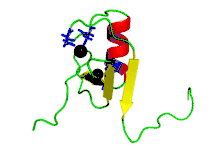RING finger
RING finger (z angl. RING – Really Interesting New Gene) je proteinová doména podobná zinkovému prstu, obsahující motiv Cys3HisCys4 (ale aminokyseliny nejsou zařazeny bezprostředně za sebou). Tento motiv je schopen vázat dva kationty zinku (Zn2+).[1][2][3][4] Rozmístění důležitých cysteinů a histidinů je možné znázornit takto: CysX2CysX9–27CysXHisX2CysX2CysX6–17CysX2Cys.[5] Má tuto konzervovanou strukturu:[1]
x x x x x x
x x x x
x x x x
x x x x
C C C C
x \ / x x \ / x
x Zn x x Zn x
C / \ H C / \ C
x x x x
x x x x x x x x x x x x x

Jsou známy stovky proteinů obsahujících RING finger.[6] Mnohé z nich hrají roli v ubikvitinaci substrátových proteinů (tzv. RING ubiquitin ligázy), což často vede k degradaci těchto substrátů.[7][6][8] Role motivu RING finger zřejmě skutečně spočívá v přenášení ubikvitinu z E2 enzymů na cílový substrát.[6]
Reference
V tomto článku byl použit překlad textu z článku RING finger na anglické Wikipedii.
- Borden KL, Freemont PS. The RING finger domain: a recent example of a sequence-structure family. Curr. Opin. Struct. Biol.. 1996, s. 395–401. DOI 10.1016/S0959-440X(96)80060-1. PMID 8804826. (anglicky)
- Hanson IM, Poustka A, Trowsdale J. New genes in the class II region of the human major histocompatibility complex. Genomics. 1991, s. 417–24. Dostupné online. DOI 10.1016/0888-7543(91)90327-B. PMID 1906426. (anglicky)
- Freemont PS, Hanson IM, Trowsdale J. A novel cysteine-rich sequence motif. Cell. 1991, s. 483–4. DOI 10.1016/0092-8674(91)90229-R. PMID 1991318. (anglicky)
- Lovering R, Hanson IM, Borden KL, Martin S, O'Reilly NJ, Evan GI, Rahman D, Pappin DJ, Trowsdale J, Freemont PS. Identification and preliminary characterization of a protein motif related to the zinc finger. Proc. Natl. Acad. Sci. U.S.A.. 1993, s. 2112–6. DOI 10.1073/pnas.90.6.2112. PMID 7681583. (anglicky)
- Oxford dictionary of biochemistry and molecular biology; revised edition. Příprava vydání R. Cammack et al. New York: Oxford university press, 2006. ISBN 0-19-852917-1.
- Joazeiro CA, Weissman AM. RING finger proteins: mediators of ubiquitin ligase activity. Cell. 2000, s. 549–52. Dostupné online. DOI 10.1016/S0092-8674(00)00077-5. PMID 11007473. (anglicky)
- Lorick KL, Jensen JP, Fang S, Ong AM, Hatakeyama S, Weissman AM. RING fingers mediate ubiquitin-conjugating enzyme (E2)-dependent ubiquitination. Proc. Natl. Acad. Sci. U.S.A.. 1999, s. 11364–9. DOI 10.1073/pnas.96.20.11364. PMID 10500182. (anglicky)
- Freemont PS. RING for destruction?. Curr. Biol.. 2000, s. R84–7. Dostupné online. DOI 10.1016/S0960-9822(00)00287-6. PMID 10662664. (anglicky)